Solarizing Alaska
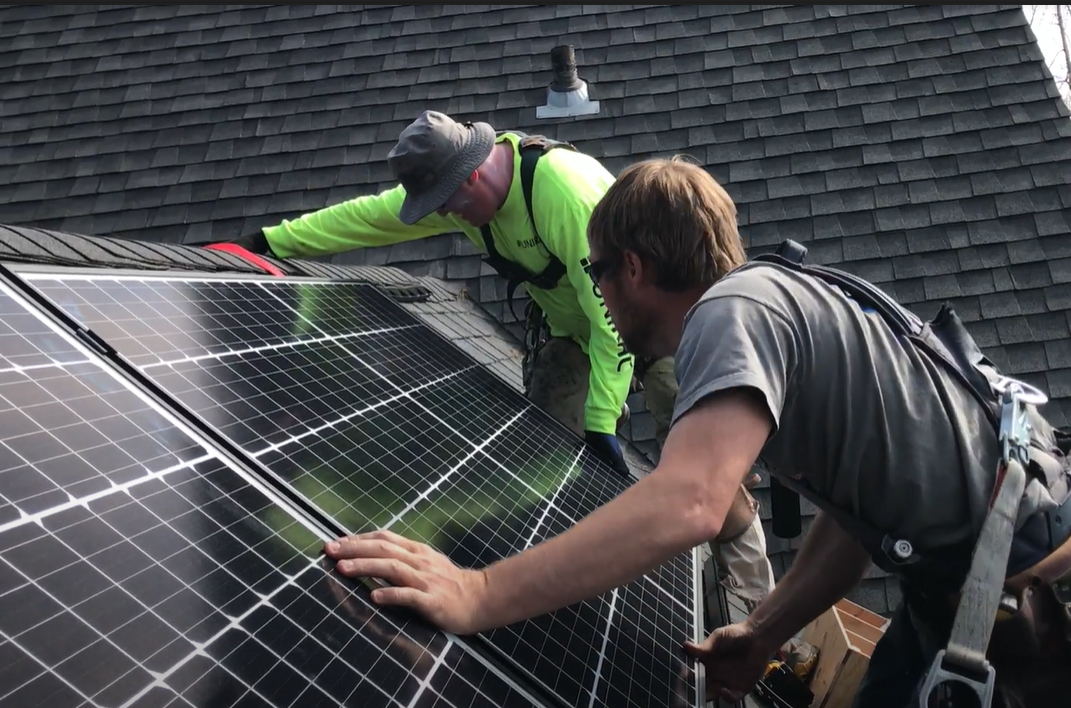
Solar installation
By Amanda Byrd
June 5, 2020
Investing in solar power in Alaska may be a better bet than the stock market.
Community Support for Solarize Fairbanks
The four solar arrays near the Cold Climate Housing Research Center (CCHRC) in Fairbanks, Alaska, give a sense of energy and innovation. They stand like a south-facing guard of honor. The center designs, tests and builds high-latitude energy-efficient homes for Alaska and other circumpolar communities.
It is also the headquarters for the Solarize Fairbanks campaign, a community-led effort and campaign to lower the barriers to the adoption of solar photovoltaic (PV) technology in Fairbanks. It is where I find Jamie Hansen, principal consultant for Information Insights and co-director for Solarize Fairbanks.
“We’re increasing the number of solar installations in the Fairbanks area,” says Hansen.
Located in the sub-Arctic, Fairbanks is at a latitude of almost 65 degrees north, only a degree and a half below the Arctic Circle. It is known for long dark winters and northern lights — not, apparently, the most logical place for solar energy installations. However, the sun shines for around 20 hours a day during the summer months. And, thanks to the latest Solarize campaign, more residents are interested in solar than ever.
Why are more and more people outlaying their own cash to generate electricity when already connected to a stable energy grid? In a time of a global pandemic, some residents seem more determined to invest in solar energy.
The first Solarize campaign was a grassroots neighborhood program in Portland, Oregon. Neighbors decided that building multiple solar installations together would increase their knowledge and potentially secure a better deal. The project gained support from the U.S. Department of Energy (DOE), a CCHRC research partner.
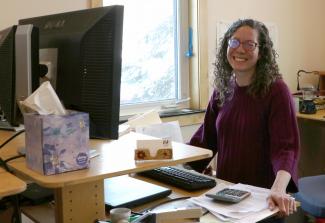
Jamie Hansen is a co-director for Solarize Fairbanks.
It worked so well that in 2011, DOE’s National Renewable Energy Laboratory, the only federal laboratory dedicated to renewable energy and energy efficiency technologies, created a handbook to guide communities on the “collective purchasing” of residential solar photovoltaic systems. Grouping homes to purchase solar power together significantly reduces the installation cost for each purchaser.
In 2018, the nationwide Solarize residential solar program was adopted in Anchorage, Alaska. By the end of 2019, Solarize Anchorage had helped more than five neighborhoods and over 200 homes receive discounted solar installations.
As of the end of 2019, there were around 8 megawatts of solar PV installations in Alaska, including 5,636 kilowatts net metered on the Railbelt (between Fairbanks and Homer), a 1,200-kW Renewable Independent Power Producers installation in Willow, and a 563-kW utility installation in Fairbanks. In the last year alone, the installed capacity on the Railbelt has nearly doubled.
The program kicked off in Fairbanks in late 2019, and, by late January 2020, five areas had rallied interest to receive the discounted installations. Lacking community councils, Fairbanks organized by general areas, including Goldstream Valley, Ester, Steese Highway, College Road, and Eielson Farm Road.
“I don’t have the exact numbers, but Goldstream has over 70 homeowners who have said that they are interested in getting a solar assessment. It’s in the 15 to 25 [home] range for the others,” says Hansen.
Two local energy companies bid for the installations in the Goldstream area. Having more than one company ensures a competitive rate, Hansen says. “I am so amazed at the prices; we’ve been calling them Anchorage prices. For our presentations, we have been estimating $4 per watt, for the average 4-5 kW system. It is under $3 a watt. That’s over a 25 percent savings (regular Fairbanks solar installation rates).”
Solar panels are priced per watt, including installation. The term “watt” refers to the amount of energy each photovoltaic panel can, with the help of an inverter, turn into electricity.
These prices are estimated before a tax credit is applied. With the credit, installed costs could be even lower.
Goldstream resident and University of Alaska Fairbanks professor emeritus Terry Chapin has been leading the charge in the Goldstream area.
Chapin had been looking into ways to reduce his energy use; it seemed so daunting that he never actually took any steps to make it happen. He was impressed by the Solarize Anchorage campaigns and how the program brought people together, allowed a great price break due to economies of scale, and leveraged local energy experts to guide residents to make informed decisions on how to proceed. He wanted to be a part of that in Fairbanks.
“It started with the informational meeting last November (2019) that Solarize Fairbanks organized, and 155 people came to that meeting,” says Chapin. After the meeting, he went through the attendance list and contacted all of those people from Goldstream, including others he knew who were interested and people in different networks. He says it was the power of social networks that really helped connect so many interested people. Instead of neighborhoods, like Anchorage, the Fairbanks area is divided by road commission areas, and this proved to be another resource.
“I started to contact people that I knew, and then asked them to contact people on their road system to help get the word out,” he says. Chapin got intentional and reached out to every Goldstream Valley Facebook site and even those in the areas surrounding the valley. Through those initial efforts, he found around 100 people interested in solar energy and 75 people who were interested in installing in the summer of 2020.
As I spoke to Hansen, Goldstream Valley had just selected their installer. Solarize announced that ABS Alaskan also won the bids for the Ester and the combined College/Eielson Farm Road areas.
Jim Norman, owner of ABS Alaskan, says that he assumes a 50% retention rate of people who say they are interested. In Fairbanks, 173 households and businesses applied through the Solarize program. Assuming past retention rates, Norman thinks 70 to 80 homes will go through with the installation.
The Impacts of COVID-19
Right now, the economy is unstable due to the COVID-19 pandemic. But, Norman says, “Assuming the economy doesn’t tank the whole Solarize program, there’s going to be a lot of solar going in Alaska.” Down in the Kenai Peninsula, another Solarize campaign has organized 80 households.
However, in Fairbanks, the College Road area Solarize group all but dissolved, as they were mostly commercial buildings. Because the coronavirus has forced many businesses to close, employees are in a holding pattern or laid off, and budgets have tightened.
Chapin says that of the 75 Goldstream people that he rallied, only one-third have returned their site assessment requests. The drop-off concerns him. “I am not sure if it’s because people are so consumed because they have had to change their lives, concerned about their health risks, or the economic impact [the virus] has had on their lives,” he says — or some combination of all three.
At Solarize Fairbanks, Hansen has also seen the effects of the pandemic. “We have had individuals and businesses pull out of the program, due to the already substantial losses from retirement savings in the stock market and business closures.” She thinks many more people who may have been interested or on the fence will simply put solar installations on hold.
The Solarize program plans to move forward, however. Solarize Fairbanks acts as an organizational framework, supporting residents as an information clearinghouse and helping residents get the best discount. Chapin is hoping to keep the momentum going through personal outreach, even if it has to be socially distant.
“We will be checking in the area organizers [like Chapin], and with the installers to make sure that the installations are being done as proposed,” says Hansen.
Reduced But Significant Costs, Diverse Motivations
The costs, even with the deep discounts, are not insignificant. The average Fairbanks solar installation price for a home can be anywhere from $10,000 to $30,000. The price is dependent on the array size, generally calculated in watts. Using the discounted installed cost of $3 a watt, before the tax credit, a home installation of 5 kW would cost around $15,000. According to the Golden Valley Electric Association’s website, a typical home in Fairbanks uses around 600 kWh per month.
Residential installations generally fall into two categories, according to Norman. “It is dependent on what the customer wants to accomplish,” he says during a phone interview.
Norman asks his customers what they want to gain in putting in a solar system, “Some people want a minimum sell-back system, so we’ll size it to their summer load balance.” Often, the summer energy load is lower than the winter energy use, so the resident will offset only a portion of their annual electricity use during the summer months.
Other people, he adds, aim for a net-zero system, or producing all or more of their electricity use from solar. Producing all of your electricity from solar power requires more arrays, as in the winter there is less sunlight. “You need to have the roof (or ground) space for it,” he says.
Chapin recalls a conversation with Norman where he explained that the most cost-efficient system would be one that matched a home’s electricity usage over the summer months, but that going beyond that requires a larger installation. This larger installation, however, would have a longer payback, according to Norman.
Longtime Fairbanks resident Eric Muehling installed solar panels on two rental cabins he owns off Farmers Loop. The iconic cabins, seen from the Alaska Dog Mushers Association trails, each boast a large, vertical 5 kW solar array. Muehling installed these 10 to12 years ago, before solar installation prices started their steep descent.
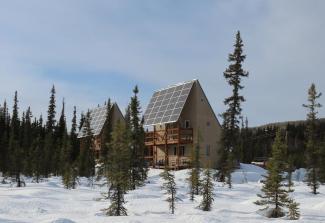
The 5-kilowatt solar arrays on Eric Muehling's cabins together generate over 8,500 kW throughout the year.
“It was the right thing to do,” says Muehling. “It was the right thing for the Earth.” His initial cost was a cash outlay of $80,000, and there was a 30 percent tax incentive that he could use against his 18 rental properties, which offset some of the cost. He expected it would take 20 years to pay off, and the installed price was $8 a watt.
Installation prices have since dropped, with the help of the economies of scale afforded by the Solarize program, to below half of what Muehling paid. This helps incentivize a new solar purchaser like Chapin.
Despite the higher cost and longer payback, Chapin says he wants to go with a larger installation, “just as a matter of principle. I’d like to offset my annual energy use.” He adds that he would like to shift from a fuel-burning heating and domestic hot water system to an electric heating system. He is also considering an electric vehicle, especially if he is producing more electricity than he is using in the summer.
The average Fairbanks and Anchorage residential solar installation is in the 3-4 kW range. Using NREL’s PVWatts calculator to model Fairbanks annual solar radiation, this size solar installation could produce 4,041 kWh a year, averaging at 336.7 kWh per month. That is more than half of the average Fairbanks’ resident’s electricity use. At the GVEA residential electric rate of 24 cents per kilowatt-hour, the installation would pay for itself in 12 years.
Additional Incentives: Tax Incentives and Net Metering
If you add in the 26 percent federal government tax incentive for residential and business solar electric and solar heating installations, that could knock the Solarize-discounted 4 kW-installed cost down from $12,000 to $8,880, giving a payback period of just around nine years. (Unfortunately, these rebates will decline to 22 percent in 2021, and go away in 2022.)
Other incentives, like net metering, also make solar power attractive. Net metering is a billing agreement between customers and the energy utility. It allows a solar producer to receive credits on their electricity bill when their solar panels produce excess electricity and sends that electricity to the power grid.
A recent report from the UAF Alaska Center for Energy and Power’s Chris Pike says there are 1,087 customers with solar power who participate in net metering on Alaska’s Railbelt grid. The Railbelt is an interconnected transmission backbone that extends 600 miles from the Kenai Peninsula to the greater Fairbanks region.
GVEA’s Sustainable Natural Alternative Power (SNAP) program is a net-metering program that currently purchases unused, renewably generated electricity from its customers at a rate of 10.4 cents per kWh. The electricity rate customers pay is around 24 cents per kWh. Therefore, effectively, a homeowner could potentially generate more than enough electricity for the household’s needs through a solar panel, and make a profit by selling excess generated electricity back to the grid.
Muehling stands in his driveway looking over his annual SNAP producer report. From just one of his 5 kW arrays, titled Midnight Sun SNAP – A, he generated 4,266 kWh from April 2019 through the end of March 2020. Combined with Midnight Sun SNAP – B, that is over 8,500 kWh generated by solar power in a year. The report also lets him know how much carbon dioxide his solar power prevented from being released into the atmosphere — it’s in the hundreds of tons since the system was installed.
“It wasn’t about the money,” Muehling says matter-of-factly.
Having solar and being connected to the electric grid has advantages.
“The thing I really like about the GVEA net metering system is that GVEA acts as a battery bank for the solar that you produce,” says Chapin. “With solar panels, I am sure I will produce more electricity during the day than at night, and I’ll produce more on sunny days than cloudy days. GVEA adds up the monthly electricity bill, and if I produce more during the day than at night I will use GVEAs energy at night.”
“And, you don’t need a fancy battery system; GVEA gives you that service for free,” Chapin adds.
He adds that if there’s a stretch of cloudy weather, he wouldn’t have to worry about it because GVEA will produce the electricity he needs during those times. He says that GVEA will add up the amount of electricity he has produced and charge him only for the amount he has purchased from the grid. If he has produced more, he will receive a payment at the retail rate.
As a note, GVEA encourages solar installations and the use of the grid infrastructure to provide energy stability; however, this service is not free to others. There are infrastructure costs associated with powerlines and generators that are not reimbursed when a member uses GVEA's grid as energy backup.
The electric rate members pay is part of the infrastructure model that determines the cost of energy per kilowatt. Cooperative members who displace a portion of their power by solar or other renewables do not pay this full infrastructure rate; it is spread across the other uses, which could impact their electric rates.
A household solar battery system is an option if one’s home is not connected to a grid, or if one is concerned about electricity connectivity during a widespread power outage. There are various battery systems available to homes and businesses. This is a larger expense, but may be important if there is not a stable electric grid you can connect to, or if one is interested in using all of the solar power produced. The added expense will add years to one’s system payback and might not be as cost-effective as using the grid as the battery.
The Perks of Sunshine in Snowy Places
These economic benefits may help explain why, despite the high latitude and dark winters, there’s recently been a lot of solar installed in Alaska.
Erin Whitney, the Solar Technologies Program manager for the Alaska Center for Energy and Power, based at the University of Alaska Fairbanks, says there are currently around eight megawatts of solar PV installed in the state.
“Although Alaska’s high latitude creates large fluctuations in sunlight throughout the year, computer simulations show the solar PV potential in Alaska to be on par with or greater than that of Germany, one of the largest solar PV power markets in the world,” says Whitney in an email interview.
She adds that Alaska does actually get an abundance of sun, especially in the summer, and there is a high albedo, or sunlight reflectance, from snowy surfaces in the shoulder seasons of fall and spring.
“I used to tell people that the highest month for producing [solar power] was April because of albedo,” says Muehling. The summer clouds, Muehling explains, drop the energy generation down to 90 percent of their potential when it is sunny. “In April, you’re double-dipping from the sky and off the snow.” His solar panels are an older style that works more efficiently with direct sunlight to generate any electricity.
Muehling’s SNAP report shows that the highest rate of generation occurs in April and May. Those two months saw one of his 5 kW arrays produce 1,195 kWh. June through August saw 1,777 kWh, September through November produced 1,019 kWh, and the winter months of December through February saw a measly 19 kWh.
“My solar panels are producing more electricity than my tenants are using on an annual basis. That means those cabins have a zero net footprint from electricity. That’s what I like about 10,000 watts,” says Muehling.
Beyond the Big City: Solar Installations in Remote Communities
The growth in solar installations has changed the energy landscape in small Alaska communities like Ambler, located in the Northwest Arctic Borough (NWAB) on the north bank of the Kobuk River and 45 miles north of the Arctic Circle.
In 2013, the community, whose 287 people rely on diesel shipped in by airplane, commissioned an 8.4-kW solar array on their water treatment plant. The NWAB energy website provides details of 14 other solar installations in high-Arctic communities.
The website states, “peak production for the solar arrays occurs during the springtime. This is due to the increase in daylight, as well as the generally sunny days that this area experiences.” Daily, live energy generation displays show an increase of 30 percent energy generation during springtime from albedo.
Even on a cloudy day, the solar panels generate some energy. A battery system has not been installed in Ambler at this time. A battery can be a very expensive investment; however, if it means using solar energy when the sun isn’t shining, it could be a game-changer for the small community.
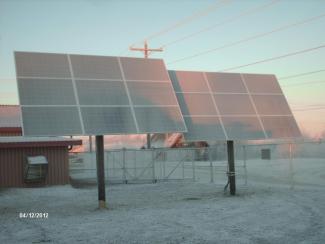
Ambler's solar installation saves the community over $20,000 in electric charges.
Storage is incorporated in other remote communities like Kongiganak on Alaska’s Yukon-Kuskokwim Delta. Here, a wind farm combined with a battery energy storage system allows the small community to turn its diesel generators off for weeks at a time. This is an enormous cost saving for a rural community whose average household income is between $40,000 and $60,000.
Ambler’s solar installation has produced more than 34.64 megawatt-hours of electricity since its commissioning in 2013, at a cost of $0.60 per kWh — saving over $20,700 for the small community. Considering the costs associated with flying in diesel fuel, these savings can be used for other purposes in the community.
However, not all utilities are equally set up for solar power. Smaller utilities across Alaska might have to increase rates if more homes installed solar. The utility would sell fewer kWh to the community but still has to pay fixed costs for personnel, lines, poles, metering and more. And their diesel generators still have to hold enough electricity in “spinning reserve” for when the sun does not shine, or a cloud or snow covers the solar panels and residents need the utility to bridge the energy gaps.
The Big Picture
Understanding the solar resource in Alaska is important; Whitney and her team at ACEP have been working to responsibly increase the use of solar PV in Alaska and the Arctic. Whitney says that since ACEP started tracking solar data in 2012, solar technology has dramatically decreased in price.
The cost of installation is also affected by economies of scale. A dramatic price decrease in 2016, according to Solar Energy Industries Association, was due in part to a large increase in national installation rates and associated lower cost of parts and labor. Essentially — the larger the project, the lower the cost.
According to Whitney’s ACEP team in a published scientific paper, before the drop in solar prices in 2016, the installed cost in Alaska was anywhere between $3.19 and $13.33 per watt for systems smaller than 24 kW, and the lower installed costs were due in part to using volunteer installation labor.
Whitney’s report shows that through the Solarize Anchorage program in 2018 and 2019, the costs of projects ranged from $1.25 to $4.60 per watt. By helping residents install solar in neighborhood batches, the Solarize program has lowered costs to be lower than average for the United States — a novel feat in Alaska, where electricity is typically quite expensive.
Norman says that nobody really knows the lifespan of solar systems in Alaska. “There’s not a whole lot that can go wrong. Heat is the main problem, and the climate in Alaska is not hot enough to cause damage. We’ve got systems that have been installed for 30 years.” Norman has been offering that life expectancy to his customers.
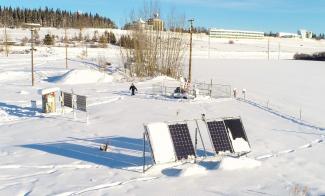
The Solar Test Site at the University of Alaska Fairbanks measures albedo off the snow with its bifacial solar panels and is part of a solar data collection project across the state.
“That (long lifetime),” Norman continues, “actually creates a problem, especially with a person’s roof. If you’ve got a solar system installed on your roof, you don’t want to be replacing your roof in 10 years.” Therefore, planning ahead is essential.
Chapin sees this as just the start of a larger Fairbanks and Goldstream Valley Solarize effort. “One of the things that is challenging in Fairbanks is most social communities come together through a political perspective, but there’s not a sense of neighborhood because we are so spread out,” Chapin says. He would like to build communities across these political divides and let people realize how much they have in common.
And, with the global pandemic affecting so many people’s lives, Chapin feels that having some homegrown energy security would be important, too.
“I’d just as soon become as economically self-sufficient as possible, so if I have the capacity to produce all my own electricity almost at no cost a decade from now, now is the time to invest in that. It’s safer than investing in the stock market in terms of the payback,” Chapin adds.


